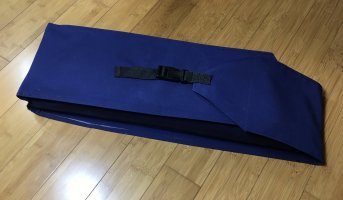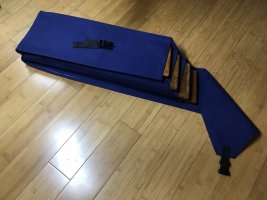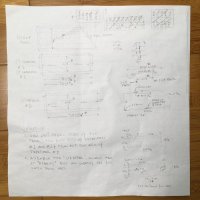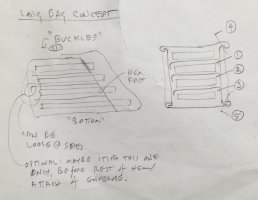peaman
Sustaining Member
An Ericson-owning friend convinced me a year ago to buy a Sail-Rite sewing machine, and I have found it to be a really good tool. One of my first "original" creations provides a way to stow Ericson original companionway hatch boards to keep them together with minimum wear and tear. A few people have encouraged me to share the design, so here it is.

The finished article, with a webbing strap and buckle for adjustable closure.

The hatch boards are placed in their individual pockets so they don't wear against one another. The longest board usually has a metal lock hasp, so a wearing pad should be placed where shown on the sketch below to minimize damage to the envelope or other hatch boards.

Sketch showing fabrication of pieces and overall assembly. Sunbrella is suggested as the fabric for the envelope, and the reinforced patch for the lock hasp can be Sail-Rite "Shelter-Rite" vinyl, additional layers of Sunbrella, or other wear resistant material. Dimensions shown above may need to be adjusted according to need. An asterisk (*) has been placed next to some dimensions requiring verification according to your own hatch boards. Dimensions shown apply to my 1987 E32-3.

Sketch showing general construction of the envelope. in the sketch at right, the numbers indicate the required or recommended sequence for sewing.
I have come to greatly appreciate having this envelope, as it keeps the boards together in a stylish and convenient protective container. If you decide to make your own, and have questions, I will be happy to answer them as well as I can, either here, or by PM.

The finished article, with a webbing strap and buckle for adjustable closure.

The hatch boards are placed in their individual pockets so they don't wear against one another. The longest board usually has a metal lock hasp, so a wearing pad should be placed where shown on the sketch below to minimize damage to the envelope or other hatch boards.

Sketch showing fabrication of pieces and overall assembly. Sunbrella is suggested as the fabric for the envelope, and the reinforced patch for the lock hasp can be Sail-Rite "Shelter-Rite" vinyl, additional layers of Sunbrella, or other wear resistant material. Dimensions shown above may need to be adjusted according to need. An asterisk (*) has been placed next to some dimensions requiring verification according to your own hatch boards. Dimensions shown apply to my 1987 E32-3.

Sketch showing general construction of the envelope. in the sketch at right, the numbers indicate the required or recommended sequence for sewing.
I have come to greatly appreciate having this envelope, as it keeps the boards together in a stylish and convenient protective container. If you decide to make your own, and have questions, I will be happy to answer them as well as I can, either here, or by PM.

